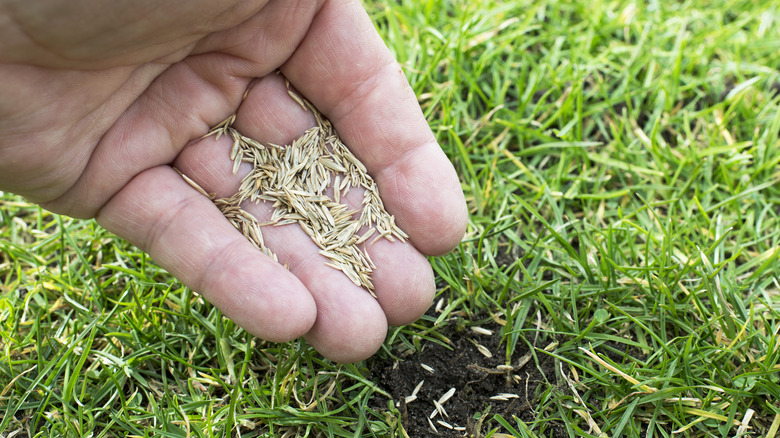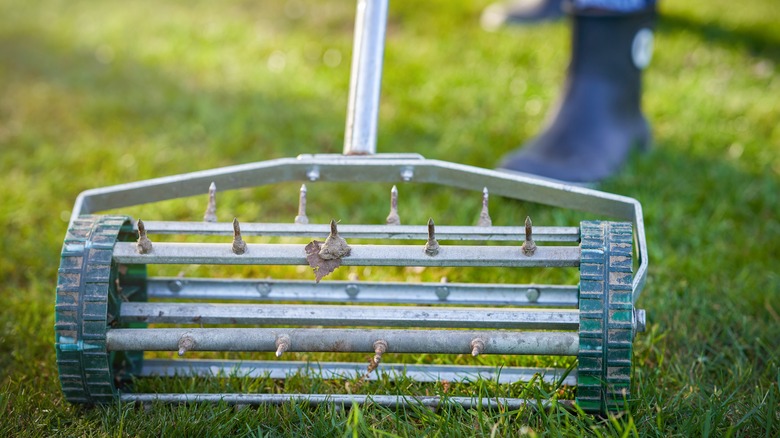Tips For Growing Grass Seed Fast To Create A Lush Lawn In No Time
Is your newly planted grass taking forever to grow? Whether you're reseeding or overseeding to cover bald spots, that perfect, lush, emerald-green lawn may seem elusive if the grass just doesn't sprout as fast as you would like. You may find that the seeds don't germinate at all. Or the seedlings may look weak, thin, and stunted, leaving you with the same barely covered spots of soil you started with.
If these struggles sound familiar, it's likely there's an issue with either the grass you're planting or the soil. It's possible that you've planted a type of grass that's unsuitable for your region or lawn conditions. At the same time, your newly sown grass seeds may have a hard time germinating because you've seeded at the wrong time. But even a well-picked grass variety won't grow well if the substrate isn't ready to support and nourish its young roots. The good news is that these mistakes are easily avoidable, and a luxuriant green lawn is within reach!
Choose fast-growing grass seeds that are suitable for your region
Not all grass is created equal, and some varieties grow far faster than others. The type of grass you choose should depend on your region and season, as weather and soil conditions affect the performance and germination times. For example, St. Augustine is a variety of grass that thrives in the hot, steamy locales along the U.S. Gulf Coast. Meanwhile, ryegrass is a lightning-fast grower that's suitable for regions with lots of moisture and mild temperatures, like the Pacific Northwest. In the coldest of locations, such as the U.S. Midwest, fine fescue is an apt choice — it's a cool-season grass that tolerates frigid weather well.
Once you've chosen your grass type, be sure to plant it at the right time to stimulate quick germination. For example, spring and summer are the best seasons for getting the St. Augustine grass type to germinate and grow quickly. That said, hot summer temperatures nearly quadruple the grass' water needs. Meanwhile, in colder climate zones, the ideal time for seeding cool-season grass like fine fescue is in the late summer. The seeds should germinate in five to 12 days if you've prepared the soil prior to sowing.
Give your seeds the best chance of sprouting quickly
Choosing a fast-growing grass is not enough to speed up germination and growth — your soil must be ready to host and nurture your seedlings to boost their progress. To prepare the soil before planting, you have to make sure it's aerated, dethatched, and fertilized. With the seeds in place, you must provide them with enough moisture to get them sprouting quickly and avoid disturbing them.
Lawn aeration is a process during which you penetrate the soil to create tiny holes. While the aeration frequency varies depending on how much foot traffic the lawn receives, it's best to aerate your soil before seeding. The holes will loosen compacted soil and allow it to absorb more air, water, and nutrients. The perforations should be at least an inch and a half deep and ⅜ inch to ⅝ inch in diameter, and you can make them with a simple coring aerator, such as from Home Depot.
Likewise, dethatching is a necessary process that removes the layer of dead organic matter from an established lawn. It's good practice to dethatch the lawn if the thatch layer is over half an inch thick, but dethatching is also helpful before you overseed. This way, the seeds will not get trapped in a mat of dead grass, and their roots will grow freely upon germination. A dethatcher, such as from Lowe's, can help you get the job done quickly. With the soil prepared, the final step before seeding is fertilization. Fertilizing nourishes grass with much-needed phosphorus, which aids root growth.


